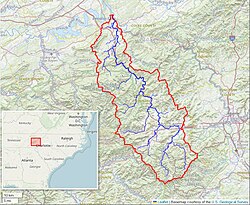Pigeon River (Tennessee–North Carolina)
| Pigeon River | |
|---|---|
 The confluence of the Pigeon River and Big Creek in Waterville, North Carolina. The power plant is in the background. | |
 Pigeon River watershed (Interactive map) | |
| Location | |
| Country | United States |
| State | North Carolina, Tennessee |
| Physical characteristics | |
| Source | West Fork Pigeon River |
| • location | below Mount Hardy in Haywood County, North Carolina |
| • coordinates | 35°18′11″N 82°55′05″W / 35.30306°N 82.91806°W[1] |
| • elevation | 5,320 ft (1,620 m) |
| 2nd source | East Fork Pigeon River |
| • location | below South Spring Top in Haywood County, North Carolina |
| • coordinates | 35°19′37″N 82°49′47″W / 35.32694°N 82.82972°W[2] |
| • elevation | 4,190 ft (1,280 m) |
| Source confluence | |
| • location | south of Canton, North Carolina |
| • coordinates | 35°28′43″N 82°52′55″W / 35.47861°N 82.88194°W[3] |
| • elevation | 2,644 ft (806 m) |
| Mouth | French Broad River |
• location | Irish Bottoms in Cocke County, Tennessee |
• coordinates | 36°01′28″N 83°11′47″W / 36.02444°N 83.19639°W[3] |
• elevation | 1,001 ft (305 m)[3] |
| Length | 70 mi (110 km)[4] |
| Basin size | 704 sq mi (1,820 km2)[5] |
| Discharge | |
| • location | Newport, Tennessee, 6.8 miles (10.9 km) above the mouth(mean for water years 1945–1983)[6] |
| • average | 1,256 cu ft/s (35.6 m3/s)(mean for water years 1945–1983)[6] |
| • minimum | 38 cu ft/s (1.1 m3/s)October 1952[6] |
| • maximum | 50,000 cu ft/s (1,400 m3/s)February 1902[6] |
The Pigeon River of Western North Carolina and East Tennessee rises above Canton, North Carolina, is impounded by Walters Dam, enters Tennessee, and flows into the French Broad River, just past Newport, Tennessee. The river traverses the Pisgah National Forest and the Cherokee National Forest, and drains much of the northeastern Great Smoky Mountains National Park.
The river takes its name from the
Course
The Pigeon River arises in southeastern Haywood County, North Carolina, and flows basically northwest for most of its length. However, near Pressley Mountain it turns northeast for about four miles and in the town of Canton, where it was utilized by a now-closed local paper mill, it turns north. After Canton it turns almost due west for about five miles, before resuming its northwest trend at about Clyde. From Canton, the Pigeon River flows roughly parallel to Interstate 40 for many miles. It is impounded by the Walters Dam of Progress Energy creating the long, narrow Waterville Lake. It enters Tennessee just after the village of Waterville, and continues with I-40 in the same valley northwestward through Hartford to Newport, where I-40 heads west, and the Pigeon River flows north into the French Broad River.
History
The Pigeon River dam was started in 1927 and was completed in 1930. The project was started by
The floods following the series of storms spawned by
A large

Recreation
Recreational rafting is popular in two sections of the river, the Upper and the Lower. Both sections are found in Hartford, Tennessee. The Upper section begins at the powerhouse (located right on the North Carolina/Tennessee border) and features up to Class III+ whitewater rapids. The Lower section features "more modest" waves.[13]
See also
References
- ^ U.S. Geological Survey Geographic Names Information System: West Fork Pigeon River
- ^ U.S. Geological Survey Geographic Names Information System: East Fork Pigeon River
- ^ a b c U.S. Geological Survey Geographic Names Information System: Pigeon River
- ^ U.S. Geological Survey. Waynesville, NC. 1:24,000.
- ^ "Pigeon River Watershed (06010106) of the Tennessee River Basin: Watershed Water Quality Management Plan, Tennessee Department of Environment and Conservation website, 2010. Retrieved at archive.org: 7 June 2015.
- ^ a b c d United States Geological Survey, Water Resources Data Tennessee: Water Year 1979, Water Data Report TN-79-1, p. 136. Gaging station 03461500.
- ^ Burnette, Edie (4 December 2008). "Video, Books Recount Pigeon Valley History". Asheville Citizen-Times.
- ^ "Walters Dam". sections.asce.org. Archived from the original on 12 January 2003. Retrieved 4 December 2008.
- ^ Studenc, Bill (21 August 2008). "Clyde Is Back after '04 Floods". Asheville Citizen-Times.
- ^ Dale, Neal (7 May 2005). "Canton Cleanup Impresses Perdue: Lt. Gov. Tours Flood Comeback". Asheville Citizen-Times.
- ^ Schlosser, Jim (19 September 2004). "Portions of I-40 Closed Indefinitely, DOT Says". Greensboro News & Record.
- ^ Isikoff, Michael (23 November 1997). "Gore's Pollution Problem". Newsweek. Retrieved 20 July 2015.
- ^ "Walter's Power Plant at Waterville to Bridge at Hartford". American Whitewater. 2015. Retrieved 20 July 2015.
External links
- Bartlett, Richard A. (1995). Troubled Waters: Champion International and the Pigeon River Controversy. University of Tennessee Press. ISBN 978-0-87049-888-6. Retrieved 20 July 2015.
